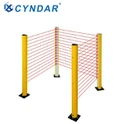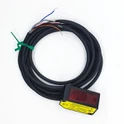Photoelectric switch (photoelectric sensor) is the abbreviation of photoelectric proximity switch. It utilizes the shielding or reflection of the light beam by the detected object, and the circuit is connected by a synchronous loop, and the presence or absence of the object is detected. It is widely used in industrial and agricultural production. Its working mechanism is that the photoelectric switch converts the input current into a light signal on the transmitter and emits it, and the receiver detects the target object according to the intensity or presence of the received light. There are DC and AC photoelectric switches. Divided into two lines, three lines, four lines and so on.
\
The two-wire power-off switch is connected in series with the load in the circuit.
The three-wire photoelectric switch is divided into NPN type and PNP type. The brown wire is connected to the positive pole of the power supply, the blue wire is connected to the negative pole of the power supply, and the black wire is the output signal wire. For the NPN photoelectric switch, the negative output is connected to the load, and the other end of the load is connected to the positive pole of the power supply. PNP type photoelectric switch, the output positive electricity is connected with the load, the other end of the load is connected with the negative pole of the power supply.
The four-wire photoelectric switch is divided into NPN normally open normally closed type and PNP normally open normally closed type, for the actual needs to choose and use.
The load can be a contactor coil, a relay coil, or a PLC. When PLC is used as a load, special attention should be paid to the matching of the positive and negative polarity of the input electrical signal, and the appropriate photoelectric NPN and PNP photoelectric switches should be selected correctly.









